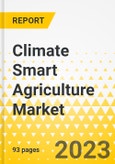Expected Emission Reduction with Precision Agriculture Adoption
This report comes with 10% free customization, enabling you to add data that meets your specific business needs.
The intricate relationships between climate change, food security, and agricultural practices underscore the need for collaborative endeavors among farmers, policymakers, and researchers to tackle this multifaceted challenge. These stakeholders are actively deploying strategies that concurrently mitigate emissions, enhance climate resilience and adaptation, and improve agricultural productivity. The adoption of climate smart agriculture (CSA) practices has emerged as a comprehensive approach to effectively pursue these interconnected objectives, taking into account the synergies and trade-offs inherent in the process.
Market Introduction
As defined by the United Nations Food and Agriculture Organization (FAO), climate smart agriculture (CSA) is an agricultural framework that offers guidance to farmers in adopting environmentally sustainable and climate resilient practices. This approach goes beyond traditional farming methods and takes an integrated approach to landscape management, including cropland, livestock, forests, and fisheries. It aims to effectively address the interconnected issues of food security and climate change. The applicability of CSA extends to countries across both the Global South and Global North, although regional contexts may result in variations in specific challenges and the prioritization of objectives.
Market Challenges:
The implementation of climate smart agriculture practices can pose financial challenges for farmers, as it often involves significant upfront costs associated with acquiring new technologies and infrastructure. Furthermore, the adoption of precision farming techniques requires investments in specialized equipment and training. However, despite these initial financial barriers, it is crucial to provide support for the adoption of climate smart agriculture practices due to their long-term advantages, such as enhanced crop yields and improved environmental sustainability.
Farmers who possess limited practical knowledge about climate smart agriculture (CSA) and are primarily motivated by economic incentives may exhibit reluctance toward adopting CSA practices. This resistance to change or aversion to risk can hinder their willingness to embrace CSA. The lack of practical understanding refers to limited awareness among farmers regarding the environmental consequences associated with conventional agricultural practices and the potential advantages offered by CSA.
The limited connectivity in marginalized areas poses a significant challenge in terms of accessing real-time data, weather forecasts, and market information essential for the effective implementation of climate smart agriculture (CSA) techniques. Bridging the infrastructure gap becomes imperative to ensure equitable access to information and resources, thereby facilitating broader adoption of CSA practices in these underserved regions.
How Can This Report Add Value to an Organization?
Primary Research
The primary sources involve the climate smart agriculture industry experts and stakeholders such as data suppliers, platform developers, and service providers. Respondents such as vice presidents, CEOs, marketing directors, and technology and innovation directors have been interviewed to verify this research study's qualitative and quantitative aspects.
The key data points taken from primary sources include:
- understanding the competitive landscape
- validation of the numbers of various markets for market type
Secondary Research
This research study involves the usage of extensive secondary research, directories, company websites, and annual reports. It also makes use of databases, such as Hoovers, Bloomberg, Businessweek, and Factiva, to collect useful and effective information for an extensive, technical, market-oriented, and commercial study of the global market. In addition to the aforementioned data sources, the study has been undertaken with the help of other data sources and websites.
Secondary research was done to obtain crucial information about the industry’s value chain, revenue models, the market’s monetary chain, the total pool of key players, and the current and potential use cases and applications.
Table of Contents
Companies Mentioned
- Hoovers
- Bloomberg
- Businessweek
- Factiva








